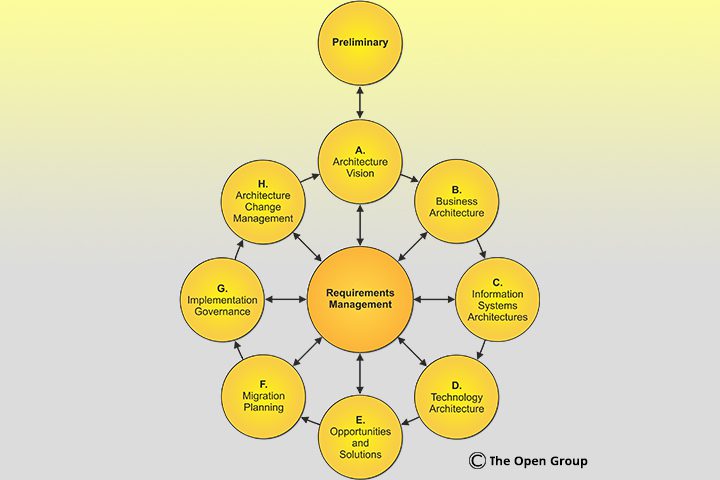

By understanding what Corporate Architecture is, I can now explain how TOGAF can be a useful framework in this category. As it has various tools that aid in the creation, production, use, and maintenance of architecture.
Since Corporate or Enterprise Architecture maps the organization from the strategy, with the design of business processes.
Therefore, it will also concern itself with how the execution of these processes will be automated, using Information Systems and identifying the technological infrastructure available for the progress of these systems.
As Corporate Architecture is at the highest level of organization, it will consequently make connections with other architectures.
Thus, TOGAF does this through the Architecture Development Method – ADM, iteratively and marked by phases.
Among them are: Architecture Vision, Business Architecture, Information Systems Architecture, Technology Architecture, Opportunities and Solutions, Migration Planning, Implementation Governance, and Architecture Change Management.
At the same time, these phases have a preliminary stage, the Principles and Framework Phase.
Considered the “heart” of TOGAF, ADM comprises and interacts with all phases through architecture domains, which ensure that all business requirements are met.
TOGAF is divided into three components:
- ADM (Architecture Development Method) – Basic structure for development architecture;
- Enterprise Continuum – Set of architectures, building blocks, and products;
- Resource Base – Set of tools and techniques.
This framework covers four architecture domains, see the list:
- Business – Defines the company’s business strategy, governance, and processes;
- Applications – Provides a model for the application system, its interactions and relationships with the company’s business processes;
- Data – Describes the logical and physical data structure of the company and all associated data management resources;
- Technology – Describes the software and hardware resources that support the deployment of business, data, and application services (e.g. IT infrastructure, standards, etc.).
TOGAF is not prescriptive, it is not a methodology, as it does not show what an organization needs to do, but rather a specific set of “architecture views”, thus offering examples of viewpoints that the architect must consider.
In addition, it provides guidelines for the selection and development of these specific viewpoints.
Apart from the various benefits for Governance and Business, TOGAF aims to improve the traceability of IT costs and seeks to reduce costs for projects, acquisition, operation, support, and changes.
Furthermore, in the project domain, it assists in a faster design and development, bringing less complexity and less risk to IT.

